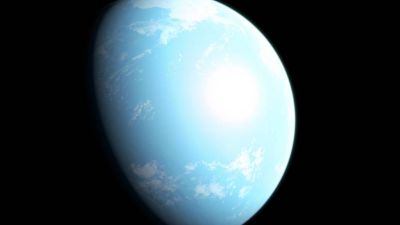NASA satellite finds new 'super-Earth' that could have liquid water and support life

A new Earth-like planet has been found by a NASA satellite that may be warm enough for liquid water to flow – and could be home to life.
The new world - named GJ 357 d - could be up to twice the size of Earth and orbits a star, GJ 357, which is one third the mass of the Sun and 40% cooler.
Little is known about GJ 357 d but scientists say the planet weighs 6.1 times the Earth’s mass and would be as cold as -53C on the surface without an atmosphere.
With an atmosphere, however, it could be a different story.
Diana Kossakowski, from the Max Planck Institute for Astronomy in Heidelberg, who co-authored the paper in Astronomy & Astrophysics, said: “GJ 357 d is located within the outer edge of its star’s habitable zone, where it receives about the same amount of stellar energy from its star as Mars does from the Sun.
“If the planet has a dense atmosphere, which will take future studies to determine, it could trap enough heat to warm the planet and allow liquid water on its surface.”
The planet orbits its star every 55.7 days at a range about 20% of Earth’s distance from the Sun.
It’s size and composition are unknown, but a rocky world with this mass would range from about one to two times Earth’s size.
Lisa Kaltenegger, a professor of astronomy at Cornell University, who published a separate paper in the Astrophysical Journal Letters, suggests the planet could harbour life.
"This is exciting, as this is humanity's first nearby super-Earth that could harbour life - uncovered with help from Tess, our small, mighty mission with a huge reach," she said.
"With a thick atmosphere, the planet GJ 357 d could maintain liquid water on its surface like Earth and we could pick out signs of life with upcoming telescopes soon to be online."
One giant leap for mankind: World marks 50 years since first step on the Moon
The Moon landing lessons that could improve your life on Earth
Tess (Transiting Exoplanet Survey Satellite) - Nasa technology used to discover planets beyond our solar system - noticed the star dimming slightly every 3.9 days in February, a hint that planets were circulating around it.
Along with GJ 357 d, NASA found two more planets, both closer to the star and far hotter.
GJ 357 b, the nearest of the three planets, is around 22% larger than Earth and orbits its star 11 times closer than Mercury does to the sun.
The middle planet, GJ 357 c, has a mass at least 3.4 times Earth's, and orbits around its star every 9.1 days.
It’s thanks to GJ 357 b’s orbit briefly dimming the star’s light from the star to NASA’s satellite, which gave the first clue planets are circling that neighbourhood in distant space.